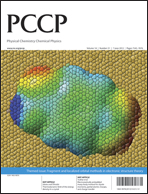A linear-scaling, embedded-fragment, second-order many-body perturbation (MP2) method with basis sets up to aug-cc-pVTZ is applied to the antiparallel structure of solid hydrogen fluoride and deuterium fluoride under 0–20 GPa of ambient pressure. The optimized structures, including the lattice parameters and molar volume, and phonon dispersion as well as phonon density of states (DOS), are determined as a function of pressure. The basis-set superposition errors are removed by the counterpoise correction. The structural parameters at 0 GPa calculated by MP2 agree accurately with the observed, making the predicted values at higher pressures a useful pilot for future experiments. The corresponding values obtained by the Hartree–Fock method have large, systematic errors. The MP2/aug-cc-pVDZ frequencies of the infrared- and Raman-active vibrations of the three-dimensional solids are in good agreement with the observed and also justify previous vibrational analyses based on one-dimensional chain models; the non-coincidence of the infrared and Raman mode pairs can be explained as factor-group (Davydov) splitting. The exceptions are one pair of modes in the librational region, for which band assignments based on a one-dimensional chain model need to be revised, as well as the five pseudo-translational modes that exist only in a three-dimensional treatment. The observed pressure dependence of Raman bands in the stretching region, which red-shift with pressure, is accounted for by theory only qualitatively, while that in the pseudo-translational region is reproduced with quantitative accuracy. The present calculation proves to be limited in explaining the complex pressure dependence of the librational modes. The hydrogen-amplitude-weighted phonon DOS at 0 GPa is much less structured than the DOS obtained from one-dimensional models and may be more realistic in view of the also broad, structureless observed inelastic neutron scattering spectra. All major observed peaks can be straightforwardly assigned to the calculated peaks in the DOS. With increasing pressure, MP2 predicts further broadening of bands and breach of the demarcation between the pseudo-translational and librational bands.

You have access to this article
 Please wait while we load your content...
Something went wrong. Try again?
Please wait while we load your content...
Something went wrong. Try again?


 Please wait while we load your content...
Please wait while we load your content...